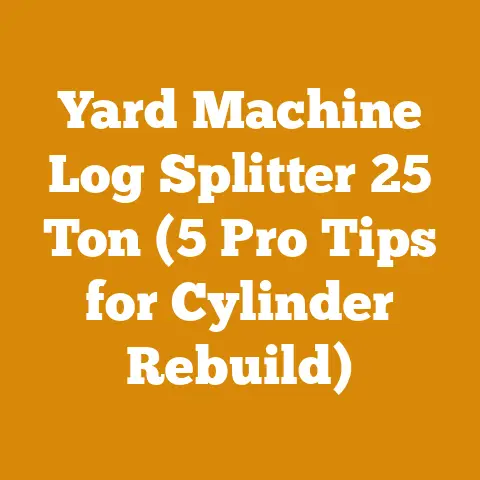20″ Bar Chainsaw Reviews (Top Mid-Range Picks for Woodworkers)
I remember summers as a kid, the smell of sawdust clinging to my clothes like a second skin. My grandfather, a man whose hands were as weathered as the oak trees he felled, taught me the value of a good saw. He always said, “A dull saw wastes more than just wood, son. It wastes time, energy, and money.” Now, decades later, I find myself passing down that knowledge, and one of the most common questions I get is about chainsaws – specifically, which 20-inch bar chainsaw offers the best bang for your buck. So, let’s dive into the world of mid-range 20-inch bar chainsaws, focusing on finding the best options for woodworkers and tackling the costs involved.
20″ Bar Chainsaw Reviews: Top Mid-Range Picks for Woodworkers
Choosing the right chainsaw is a crucial decision, and the 20-inch bar length is a sweet spot for many woodworkers. It offers a good balance of power and maneuverability, capable of felling small to medium-sized trees and handling a wide range of wood processing tasks. But with so many options on the market, it can be overwhelming. I’ll walk you through some top mid-range picks, breaking down their features, performance, and, most importantly, the costs associated with owning and maintaining them.
Why a 20-Inch Bar Chainsaw?
Before we get into specific models, let’s understand why a 20-inch bar is a popular choice.
- Versatility: It’s long enough to tackle most common tree sizes encountered in residential settings and woodworking projects. You can fell trees with a diameter up to about 40 inches (twice the bar length), although you’ll need to cut from both sides.
- Balance: It’s generally easier to control than longer bars, especially for less experienced users. This is vital for safety and precision.
- Power-to-Weight Ratio: Mid-range saws with 20-inch bars usually strike a good balance between power and weight, making them manageable for extended use without excessive fatigue.
Top Mid-Range 20-Inch Chainsaws: A Review
I’ve selected a few models that consistently receive positive reviews and offer a good value proposition for woodworkers. These saws represent a mix of gas-powered and battery-powered options, catering to different preferences and needs.
1. Stihl MS 271 Farm Boss:
- Type: Gas-powered
- Engine: 50.2 cc
- Weight: 12.3 lbs (without bar and chain)
- Features: Easy2Start system, anti-vibration system, Ematic lubrication system
- Pros: Powerful, durable, reliable, excellent cutting performance
- Cons: Can be a bit heavy for some users, requires more maintenance than battery-powered models.
2. Husqvarna 455 Rancher:
- Type: Gas-powered
- Engine: 55.5 cc
- Weight: 13 lbs (without bar and chain)
- Features: X-Torq engine (reduced emissions and fuel consumption), Smart Start system, centrifugal air cleaning system
- Pros: Powerful, durable, good value for money, well-suited for demanding tasks
- Cons: Can be challenging to start in cold weather, may require some tuning.
3. Echo CS-590 Timber Wolf:
- Type: Gas-powered
- Engine: 59.8 cc
- Weight: 13.2 lbs (without bar and chain)
- Features: Heavy-duty air filter, decompression valve for easy starting, automatic oiler
- Pros: Powerful, durable, excellent value for the price, suitable for felling larger trees
- Cons: Can be a bit noisy, heavier than some other options.
4. DeWalt DCCS690M1:
- Type: Battery-powered (40V MAX)
- Weight: 12.2 lbs (with battery)
- Features: Brushless motor, chain brake, tool-free chain tensioning
- Pros: Quiet, easy to start, low maintenance, no emissions
- Cons: Limited run time compared to gas-powered models, less power than some gas-powered options, battery and charger add to the initial cost.
5. Milwaukee M18 FUEL 2720-21HD:
- Type: Battery-powered (M18)
- Weight: 13.9 lbs (with battery)
- Features: Brushless motor, high-output battery, tool-free chain tensioning
- Pros: High performance for a battery-powered saw, quiet, easy to start, low maintenance
- Cons: Expensive, battery life is dependent on the type of work being done, requires compatible M18 batteries.
Detailed Cost Analysis: From Purchase to Maintenance
Now, let’s delve into the cost factors associated with owning and operating these chainsaws. This is where things get interesting, and where understanding the nuances can save you a significant amount of money in the long run. I’ll break down the costs into several categories: initial purchase price, fuel/battery costs, maintenance, and replacement parts.
1. Initial Purchase Price:
This is the most obvious cost. Here’s a rough estimate of the price range for the models mentioned above (prices can vary depending on the retailer and any ongoing promotions):
- Stihl MS 271 Farm Boss: \$450 – \$550
- Husqvarna 455 Rancher: \$400 – \$500
- Echo CS-590 Timber Wolf: \$400 – \$500
- DeWalt DCCS690M1: \$400 – \$500 (includes battery and charger)
- Milwaukee M18 FUEL 2720-21HD: \$450 – \$600 (includes battery and charger)
Important Considerations:
- Bundled Deals: Look for deals that include extra chains, sharpening kits, or safety gear. These bundles can often save you money compared to buying items separately. I’ve often found great deals at local hardware stores during seasonal sales.
- Refurbished Models: Consider buying a refurbished model from a reputable dealer. These saws are often thoroughly inspected and repaired, and they come with a warranty. You can save a significant amount compared to buying a new model.
- Financing Options: Some retailers offer financing options, which can make a more expensive saw more accessible. However, be mindful of interest rates and fees.
2. Fuel/Battery Costs:
This is where gas-powered and battery-powered saws differ significantly.
- Gas-Powered:
- Fuel: The cost of gasoline can fluctuate significantly. As of late 2024, the average price of gasoline in the US is around \$3.50 – \$4.00 per gallon (source: AAA). You’ll also need to factor in the cost of 2-cycle engine oil, which is mixed with gasoline at a ratio of around 50:1. A good quality 2-cycle oil can cost around \$15 – \$20 per quart.
- Example: If you use 1 gallon of gasoline per week, and a quart of 2-cycle oil lasts you a month, your weekly fuel cost would be around \$4.00 (gasoline) + \$1.25 (oil) = \$5.25.
- Long-Term Cost: Over the lifespan of the saw, fuel costs can add up significantly.
- Battery-Powered:
- Battery Life: The runtime of a battery-powered chainsaw depends on the battery capacity (measured in amp-hours or Ah) and the type of work you’re doing. Heavier cutting will drain the battery faster.
- Replacement Batteries: Batteries have a limited lifespan. Depending on usage and storage conditions, you may need to replace the battery every 3-5 years. Replacement batteries can cost anywhere from \$100 to \$300, depending on the voltage and capacity.
- Electricity Costs: While the cost of charging a battery is relatively low, it’s still a factor to consider. A typical chainsaw battery might take 1-2 hours to charge and consume around 0.5 kWh of electricity. At an average electricity rate of \$0.15 per kWh, the cost to charge the battery would be around \$0.075 – \$0.15 per charge.
- Long-Term Cost: While the daily running costs of a battery-powered saw are lower, the cost of replacement batteries can be significant over the long term.
3. Maintenance:
Regular maintenance is crucial for keeping your chainsaw running smoothly and extending its lifespan.
- Chain Sharpening: A dull chain is not only inefficient but also dangerous. You can sharpen the chain yourself using a file or a chain grinder, or you can take it to a professional. Professional sharpening typically costs around \$10 – \$20 per chain. I prefer sharpening my own chains – it’s a skill every chainsaw owner should learn.
- DIY Cost: A good quality chainsaw file kit costs around \$20 – \$30. An electric chain grinder can cost anywhere from \$50 to \$200.
- Bar Maintenance: The chainsaw bar needs to be cleaned and lubricated regularly. You should also check the bar for wear and damage. A new bar can cost around \$30 – \$50.
- Air Filter Cleaning/Replacement: A clean air filter is essential for proper engine performance. Clean the air filter regularly with compressed air. Replace the air filter when it becomes excessively dirty or damaged. Air filters typically cost around \$5 – \$10.
- Spark Plug Replacement: Replace the spark plug periodically to ensure reliable starting. Spark plugs typically cost around \$3 – \$5.
- Oil: Chainsaw oil is essential for lubricating the chain and bar. A gallon of chainsaw oil typically costs around \$15 – \$25.
- Gas-Powered Specific:
- Carburetor Cleaning/Adjustment: Carburetors can become clogged with dirt and debris, leading to poor engine performance. You may need to clean or adjust the carburetor periodically.
- Fuel Filter Replacement: Replace the fuel filter periodically to prevent dirt and debris from entering the carburetor. Fuel filters typically cost around \$3 – \$5.
- Battery-Powered Specific:
- Battery Storage: Proper battery storage is crucial for extending battery life. Store batteries in a cool, dry place. Avoid storing batteries in direct sunlight or extreme temperatures.
4. Replacement Parts:
Even with regular maintenance, you may eventually need to replace certain parts.
- Chains: Chains wear out over time and need to be replaced. A new chain for a 20-inch bar chainsaw typically costs around \$20 – \$40.
- Bars: Bars can become bent or damaged, requiring replacement.
- Sprockets: The sprocket that drives the chain can wear out over time. A new sprocket typically costs around \$10 – \$20.
- Other Parts: Depending on the model and the type of damage, you may need to replace other parts, such as the starter, carburetor, or ignition coil.
Table: Estimated Annual Chainsaw Ownership Costs
| Cost Category | Stihl MS 271 (Gas) | DeWalt DCCS690M1 (Battery) |
|---|---|---|
| Fuel/Battery | \$150 – \$250 | \$20 – \$50 (electricity) |
| Maintenance | \$50 – \$100 | \$20 – \$50 |
| Replacement Parts | \$30 – \$70 | \$20 – \$50 |
| Total Annual Cost | \$230 – \$420 | \$60 – \$150 |
Note: These are estimates and can vary depending on usage and maintenance practices.
Digging Deeper: Cost Drivers and Variables
The costs I’ve outlined are averages, but several factors can significantly influence the actual expenses you’ll incur. Understanding these drivers is key to effective budgeting.
1. Wood Type and Density:
The type of wood you’re cutting directly impacts chain wear, fuel consumption (for gas saws), and battery drain (for electric saws). Hardwoods like oak, maple, and hickory require more power and will dull the chain faster than softwoods like pine and fir.
- Example: Cutting oak for firewood will require more frequent chain sharpening and potentially more fuel/battery power compared to cutting pine.
- Data Point: According to the USDA Forest Service, the density of oak can range from 45 to 55 pounds per cubic foot, while the density of pine is typically around 25 to 35 pounds per cubic foot. This difference in density directly translates to increased cutting resistance.
2. Frequency and Intensity of Use:
The more you use your chainsaw, the more wear and tear it will experience, leading to higher maintenance and replacement costs. A professional woodworker who uses their chainsaw daily will have significantly higher costs than a hobbyist who uses it only occasionally.
- Example: A professional logger might need to replace their chainsaw chain every few weeks, while a homeowner might only need to replace it every few years.
3. Maintenance Habits:
Regular and proper maintenance can significantly extend the lifespan of your chainsaw and reduce the need for costly repairs. Neglecting maintenance can lead to premature wear and damage.
- Example: Regularly cleaning the air filter, sharpening the chain, and lubricating the bar can prevent many common problems and extend the life of your chainsaw.
- Tip: Create a maintenance schedule and stick to it. This will help you stay on top of routine tasks and identify potential problems early on.
4. Fuel Quality (for Gas-Powered Saws):
Using high-quality gasoline and 2-cycle oil can improve engine performance and reduce the risk of engine damage. Avoid using old or contaminated fuel.
- Example: Using gasoline with a high ethanol content can damage the engine of a gas-powered chainsaw. It’s best to use gasoline with a low ethanol content or ethanol-free gasoline.
- Data Point: The EPA allows gasoline to contain up to 10% ethanol (E10). However, some small engines, like those used in chainsaws, are not designed to run on E10 fuel.
5. Battery Storage and Charging Habits (for Battery-Powered Saws):
Proper battery storage and charging habits can significantly extend battery life. Avoid overcharging or deep discharging the battery. Store batteries in a cool, dry place.
- Example: Leaving a battery fully charged for extended periods can reduce its lifespan. It’s best to store batteries at around 40-50% charge.
- Tip: Follow the manufacturer’s recommendations for battery storage and charging.
6. Location and Environmental Factors:
The environment in which you use your chainsaw can also affect its lifespan and maintenance costs. Dusty or sandy conditions can accelerate wear and tear on the chain, bar, and air filter.
- Example: Using a chainsaw in a dusty environment will require more frequent air filter cleaning.
- Data Point: According to a study by the University of California, Davis, dust and particulate matter can significantly reduce the lifespan of small engines.
Optimizing Costs: Practical Tips and Strategies
Now that we’ve covered the cost factors, let’s explore some practical tips and strategies for optimizing your chainsaw ownership costs.
1. Choose the Right Saw for Your Needs:
Don’t buy a saw that’s too powerful or too expensive for your needs. A smaller, less expensive saw might be perfectly adequate for occasional use.
- Example: If you only need to cut small branches and trim trees occasionally, a smaller, battery-powered saw might be a better choice than a larger, gas-powered saw.
- Tip: Consider the size and type of trees you’ll be cutting, the frequency of use, and your budget when choosing a chainsaw.
2. Invest in Quality Safety Gear:
Safety gear is essential for protecting yourself from injury. Invest in a good quality helmet, eye protection, ear protection, gloves, and chaps.
- Cost: Safety gear can cost anywhere from \$100 to \$300, but it’s a worthwhile investment.
- Benefit: Preventing even one injury can save you thousands of dollars in medical bills and lost wages.
3. Learn Basic Chainsaw Maintenance:
Learning basic chainsaw maintenance tasks, such as chain sharpening, air filter cleaning, and spark plug replacement, can save you money on professional service fees.
- Resources: There are many online resources, including videos and articles, that can teach you basic chainsaw maintenance.
- Tip: Start with simple tasks and gradually learn more complex procedures.
4. Sharpen Your Chains Regularly:
A sharp chain cuts faster, easier, and safer. Sharpen your chain regularly using a file or a chain grinder.
- Benefit: A sharp chain reduces strain on the engine, improving fuel efficiency and extending the life of the saw.
- Tip: Learn how to sharpen your chain properly to avoid damaging it.
5. Use the Right Chain for the Job:
Different types of chains are designed for different types of cutting. Use the right chain for the job to improve cutting performance and reduce wear and tear.
- Example: Use a ripping chain for milling lumber and a crosscut chain for felling trees.
- Tip: Consult your chainsaw manual or a knowledgeable dealer to determine the best chain for your needs.
6. Store Your Chainsaw Properly:
Store your chainsaw in a clean, dry place. Drain the fuel tank before storing a gas-powered chainsaw for an extended period. Remove the battery from a battery-powered chainsaw and store it separately.
- Benefit: Proper storage can prevent corrosion, fuel degradation, and battery damage.
- Tip: Follow the manufacturer’s recommendations for storing your chainsaw.
7. Consider Renting a Chainsaw for Occasional Use:
If you only need a chainsaw occasionally, consider renting one instead of buying one. This can save you money on the initial purchase price, maintenance, and storage.
- Cost: Chainsaw rental typically costs around \$30 – \$50 per day.
- Benefit: Renting allows you to use a high-quality chainsaw without the long-term commitment of ownership.
8. Buy Replacement Parts Online:
You can often find replacement parts for your chainsaw online at lower prices than at local dealers. However, be sure to buy from a reputable source to ensure you’re getting genuine parts.
- Tip: Compare prices from different online retailers before making a purchase.
- Caution: Avoid buying counterfeit parts, as they may not meet quality standards and could damage your chainsaw.
9. Join a Chainsaw Forum or Online Community:
Joining a chainsaw forum or online community can provide valuable information and support. You can ask questions, share tips, and learn from other chainsaw users.
- Benefit: These communities can be a great resource for troubleshooting problems, finding deals on parts, and learning about new products.
10. Keep Records of Your Expenses:
Keeping track of your chainsaw expenses can help you identify areas where you can save money. Track your fuel costs, maintenance costs, and replacement part costs.
- Tip: Use a spreadsheet or a budgeting app to track your expenses.
- Benefit: This information can help you make informed decisions about chainsaw ownership.
Case Studies: Real-World Cost Comparisons
To illustrate the impact of different factors on chainsaw costs, let’s look at a few hypothetical case studies.
Case Study 1: The Hobbyist Woodworker
- User: A hobbyist woodworker who uses their chainsaw occasionally for small projects around the house.
- Chainsaw: DeWalt DCCS690M1 (battery-powered)
- Annual Usage: 20 hours
- Maintenance Habits: Good (regular chain sharpening, air filter cleaning)
- Estimated Annual Costs:
- Fuel/Battery: \$20 (electricity)
- Maintenance: \$20
- Replacement Parts: \$10
- Total: \$50
Case Study 2: The Firewood Cutter
- User: A homeowner who cuts firewood to heat their home.
- Chainsaw: Stihl MS 271 Farm Boss (gas-powered)
- Annual Usage: 100 hours
- Maintenance Habits: Average (occasional chain sharpening, infrequent air filter cleaning)
- Estimated Annual Costs:
- Fuel: \$200
- Maintenance: \$75
- Replacement Parts: \$50
- Total: \$325
Case Study 3: The Professional Logger
- User: A professional logger who uses their chainsaw daily.
- Chainsaw: Husqvarna 455 Rancher (gas-powered)
- Annual Usage: 500 hours
- Maintenance Habits: Good (regular chain sharpening, air filter cleaning, professional service)
- Estimated Annual Costs:
- Fuel: \$1000
- Maintenance: \$200
- Replacement Parts: \$150
- Total: \$1350
These case studies demonstrate how different usage patterns and maintenance habits can significantly impact chainsaw ownership costs.
The Bottom Line: Making an Informed Decision
Choosing the right 20-inch bar chainsaw for your needs requires careful consideration of your budget, usage patterns, and maintenance capabilities. By understanding the cost factors involved and implementing cost-saving strategies, you can minimize your expenses and enjoy the benefits of owning a reliable and efficient chainsaw.
Key Takeaways:
- Gas vs. Battery: Gas-powered chainsaws offer more power and longer run times, but they require more maintenance and fuel costs. Battery-powered chainsaws are quieter, easier to start, and require less maintenance, but they have limited run times and can be expensive to replace batteries.
- Maintenance is Key: Regular maintenance can significantly extend the life of your chainsaw and reduce the need for costly repairs.
- Choose the Right Saw: Select a chainsaw that is appropriate for your needs and budget.
- Safety First: Always wear appropriate safety gear when operating a chainsaw.
Final Thoughts: A Legacy of Woodworking
My grandfather always emphasized the importance of taking care of your tools. He wasn’t just talking about oiling the chain or sharpening the blade; he was talking about respecting the craft. A well-maintained chainsaw isn’t just a tool; it’s an extension of your hands, a partner in your woodworking journey. By understanding the costs involved and making informed decisions, you can ensure that your chainsaw remains a valuable asset for years to come. Now, go out there and make some sawdust!






